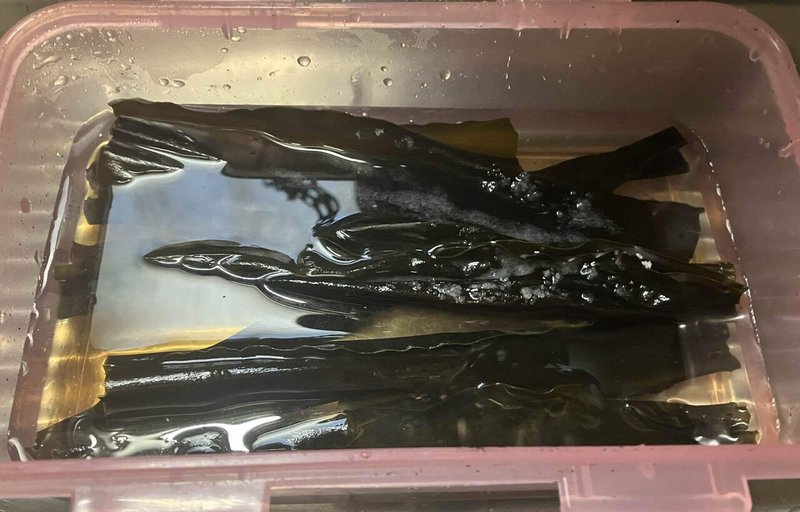
アスパラガスのお浸し Asparagus marinated in soy sauce
僕の関わったダイニングバーでアペタイザーとしてお出しして好評だった一品。アスパラガスが多く出回る季節に常備菜として作りました。動物系の出汁を使わないのでベジタリアンにもおすすめです。必要最低限の味付けでアスパラガスの旨味を引き出しています。
This was a popular appetizer at a dining bar I worked at. I made it as a side dish during the season when asparagus is plentiful. It is also recommended for vegetarians because it does not use animal-based stock. The flavor of the asparagus is brought out with the bare minimum of seasoning.
Ingredients:
材料:
昆布
鷹の爪(スライス)
薄口醤油
konbu kelp
sliced chili peppers
light type soy sauce
procedure:
手順:
下準備として、ミネラルウオーターに薄口醤油を入れ、そこに昆布と鷹の爪を浸しておく(できれば一晩、急ぐときは10分ほどでも良い)。
鍋にお湯を用意する。
As preparation, add light type soy sauce to mineral water and soak the kelp and chili pepper in it (overnight in the refrigerator if possible, but 10 minutes will do if you're in a hurry).
Prepare a pot of hot water.

アスパラガスの皮の硬い部分をピーラーなどで削り落としてから二等分する。
Scrape off the tough parts of the asparagus skin with a peeler or something similar, then cut them in half.


沸騰したお湯に二等分した材料の根の方の部分を入れて、再び沸騰したら、穂の方の部分も入れ、さらに再び沸騰したら、アスパラガスを取り出して、下準備しておいた昆布入りの出汁に熱いままのアスパラガスを素早く沈める。
Put the root parts of both halves into boiling water, bring it back to a boil, add the remaining flower parts, and when it boils again, remove the asparagus and quickly submerge the hot asparagus in the prepared broth with konbu kelp.

粗熱が取れればもう食ることができますが、できれば冷蔵庫で一晩置くと味が染みてより美味しくなります。冷蔵庫にそのまま入れておけば4、5日は保管可能です。
The asparagus can be eaten once it has cooled, but if possible, leaving it in the refrigerator overnight will allow the flavor of the broth to soak in and make it even more delicious.
You can store it in the refrigerator for 4 to 5 days.
Tips and tricks:
コツと応用のヒント:
ここでの大事なポイントは薄口醤油を使うこと。京都を源とする日本の伝統的な割烹料理の技法は素材本来の味を大切にする伝統に基づいています。薄口醤油と濃口醤油の使い分けもその技法の一つです。季節の野菜や白身魚の調味には、その繊細な味を壊してしまわないように旨味成分が控えめになるように醸造された薄口醤油を使います。昆布と薄口醤油の旨味と塩味、鷹の爪のアクセントだけの最低限の調味でアスパラガスの味わいを引き出すわけです。
もし、薄口醤油が手に入らない場合は、自然塩で八分目の味をつけて、流通量の多い濃口醤油を控えめに入れて味を整えると良いでしょう。
さらに酸味を加えたハーモニーおも楽しみたいなら、柚子などの地方原産の柑橘類の皮を刻んだものや果汁を加えるのも良い工夫です。
The important point here is to use light type soy sauce. The traditional Japanese cuisine, which originated in Kyoto, is based on the tradition of valuing the original flavor of the ingredients. The use of light type soy sauce and dark type soy sauce is one of these techniques. When cooking seasonal vegetables and white fish, light type soy sauce is used, which is brewed to have a low umami content so as not to destroy the delicate flavo of the ingredients. The flavor of asparagus is brought out with minimal seasoning, just the umami and saltiness of kelp and light type soy sauce, and the accent of chili pepper.
If you can't get light type soy sauce, you can substitute it by adding 80% natural salt and a small amount of dark type soy sauce, which is widely available, to adjust the flavor.
If you want to enjoy the harmony of sourness in this recipe, adding chopped peel or juice of local citrus fruits such as yuzu is a good idea.
Guide to where to find ingredients
材料入手先ガイド
この記事が気に入ったらサポートをしてみませんか?
